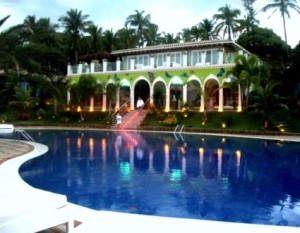
Photo © Michael Sommers.
Recently I landed what many people (including me) would consider to be a dream gig – reviewing luxury hotels in Brazil for an American-based site called Luxury Latin America.com. Naturally, reviewing a luxury hotel means getting to stay in a luxury hotel, something that most of the world’s population – including most tourists – don’t get to do on a daily basis. Aside from the (barely concealable) joy of getting to live it up to the hilt (at least for 24 hours) and go to sleep in a king-sized bed whose sheets have an astronomically high thread count, the interesting thing about staying in these hotels is analyzing just what constitutes the “concept” of luxury these days – in general, and in Brazil. Instead of importing luxury from abroad, Brazil – and the rest of the world – is starting to realize that luxury has been here all along.Historically, Brazil hasn’t had much of a luxury tourism market. Until recently, most of what existed was concentrated in the urban poles of Rio and São Paulo. Choices oscillated between a few grandly opulent European-style palaces that had survived Rio’s glamorous heyday – (for every Copacabana Palace and Hotel Glória, there are scads of other former grand hotels that survive as dilapidated one-stars and no-stars) – and ultra-modern (by ‘70s and ‘80s standards) mega hotels styled after American Hiltons and Sheratons. Most of the few Brazilians with big bucks tended to spend them abroad in Paris, New York, and Miami (Brazilians LOVE Miami), which had much more cachet than say… Minas Gerais, Bahia, or God forbid, Santa Catarina.
Around the turn of the (21rst) century, however, a couple of things started to change:
1. The rest of the world discovered Brazil. Well, they’d always known about Rio of course – and the Amazon had long fired up their imaginations. But the rest of the country was a blank until gradually the word got out that Florianópolis had an amazing surf scene; that Salvador, the world’s second-largest city of African descent, still possessed cultural rituals that no longer exist even in Africa; that São Paulo had one of the world’s most vanguard and varied culinary, cultural, and nightlife scenes; that Minas Gerais boasted the largest ensemble of preserved baroque architecture in the Americas; and that the protected archipelago of Fernando de Noronha was the next best thing to Robinson Crusoe’s island, a place where you could swim with dolphins, sun on deserted beaches, and snorkel in waters clear enough to see fish cavorting 40 meters below.
Overcrowded and overdeveloped European beaches suddenly didn’t seem so alluring when confronted with the Edenic idyll of places such as Trancoso, Jericoacoara, Pipa, and Praia do Rosa. And in fact, many Europeans – both big luxury hotel chains (mostly Spanish and Portuguese) and individuals looking to drop out and set up shop in paradise – decided to take advantage of the proximity (a 6-7 hour direct flight across the Atlantic to the Northeast coast) and the endless space, and invest in the country whose economy was booming, whose infrastructure was (in many places) approaching First World standards, and whose prospects seemed limitless.
2. Brazilians (re)discovered Brazil. With Brazil’s improved economy, an increase in disposable income across the spectrum translated into more Brazilians traveling than ever before – including a very wealthy and demanding elite (mostly from São Paulo and Rio). Due to investments in transportation and infrastructure (i.e. new airlines, revamped airports, improved roads, extensive Wi-Fi and cell phone coverage), it was suddenly easier to get away from it all – and do so in style and comfort. It suddenly became fashionable to travel at home. Exclusive boutique hotels and creative gourmet restaurants began to blossom in the midst of thriving cities as well as secluded natural refuges that could only be reached by air-conditioned SUVs, private yachts, or helicopters.
Indeed, while the United States, and much of the rest of the world, has been floundering in the wake of the 2008 economic crisis, Brazil has already pulled itself out of the mire and is busy investing in tourism, and for the first time ever, in luxury tourism.
Even the Brazilian government has gotten in on the act. The Ministry of Tourism’s agency, Embratur, has taken to the international marketplace to sell Brazil as an alternative to well-worn North American, European and Asian destinations. For the first time ever – in conjunction with the new Brazilian Luxury Travel Association (BLTA), created in 2008 – it is promoting the country as a luxury travel destination, placing particular emphasis on the growing eco-luxury market (from the Amazon and the Pantanal to its 8,000-km coastline, Brazil is certainly not lacking into eco-treasures).
What’s so interesting about the new 21st-century concept of luxury in Brazil is that it combines the best of both worlds: high-quality comfort and personalized service that North American and European travelers demand, with rich local cultures, cuisines, and paradise-worthy locales. You can have your Trussardi sheets, iPod ports, flat screen TVs, and Nespresso machines, but instead of a gilt Louis XV commode, the bedside table might be made of ecologically harvested, artisanally crafted tropical wood, pães de queijo might substitute the breakfast croissants, the bathroom soap will smell of Amazonian cupuaçu, and you’re likely to take away the ultimate souvenir: a complimentary pair of Havaiana flip flops.
As I review these hotels, what strikes me most is that that luxury isn’t about opulence or grandeur anymore. It’s about comfort, spaciousness, and a sensation of getting away from it all. It’s about casualness, intimacy, and letting down one’s hair. It’s about beauty, originality, nature, sensuality, and relaxation. It’s about all of these things that Brazil has in spades. Instead of importing luxury from abroad, Brazil – and the rest of the world – is starting to realize that luxury has been here all along.